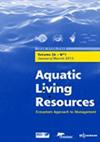Portfolio of distribution maps for Octopus vulgaris off Mauritania
IF 1.9
4区 农林科学
Q3 FISHERIES
引用次数: 0
Abstract
This study introduces the concept of portfolios of distribution maps, which consist of the reduced set of empirical orthogonal maps that best explain spatial biomass distributions of a given species over time. The approach is demonstrated for the distributions of common octopus (Octupus vulgaris) off Mauritania over the last thirty years. The maps in the portfolio are the subset of empirical orthogonal maps that allowed to recover 60% of the spatiotemporal biomass distribution variance and whose temporal weights were significantly correlated with abundance. For octopus during the hot season, one single map explained half of the overall variance of the distribution data, while during the cold season, the portfolio of octopus distribution maps consisted of four maps, with the temporal weights of the second map being negatively correlated with upwelling intensity six months before. The size of each portfolio represents the number of distinct spatial patterns describing octopus spatial distributions. Assuming that specific but hidden processes explain each biomass spatial distribution of the portfolio, the size of a map portfolio might be interpreted as a proxy for system resilience. A small portfolio could reflect systems that are more fragile.
毛里塔尼亚的章鱼分布地图组合
本研究引入了分布图组合的概念,它由最能解释给定物种随时间的空间生物量分布的经验正交图的简化集组成。该方法在毛里塔尼亚近三十年来常见章鱼(Octupus vulgaris)的分布中得到了证明。组合中的地图是经验正交图的子集,可以恢复60%的时空生物量分布方差,其时间权重与丰度显著相关。在炎热季节,一张章鱼分布图可以解释一半的分布数据,而在寒冷季节,章鱼分布图组合由4张图组成,第二张图的时间权重与上升流强度前6个月呈负相关。每个组合的大小代表了描述章鱼空间分布的不同空间模式的数量。假设特定但隐藏的过程解释了组合的每个生物量空间分布,则地图组合的大小可能被解释为系统弹性的代理。一个小的投资组合可能反映出更脆弱的系统。
本文章由计算机程序翻译,如有差异,请以英文原文为准。
求助全文
约1分钟内获得全文
求助全文
来源期刊

Aquatic Living Resources
农林科学-海洋与淡水生物学
CiteScore
2.30
自引率
0.00%
发文量
10
审稿时长
>24 weeks
期刊介绍:
Aquatic Living Resources publishes original research papers, review articles and propective notes dealing with all exploited (i.e. fished or farmed) living resources in marine, brackish and freshwater environments.
Priority is given to ecosystem-based approaches to the study of fishery and aquaculture social-ecological systems, including biological, ecological, economic and social dimensions.
Research on the development of interdisciplinary methods and tools which can usefully support the design, implementation and evaluation of alternative management strategies for fisheries and/or aquaculture systems at different scales is particularly welcome by the journal. This includes the exploration of scenarios and strategies for the conservation of aquatic biodiversity and research relating to the development of integrated assessment approaches aimed at ensuring sustainable and high quality uses of aquatic living resources.
 求助内容:
求助内容: 应助结果提醒方式:
应助结果提醒方式:


